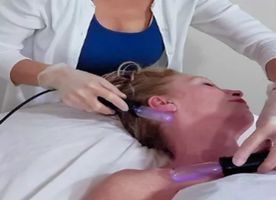Watsu in Vietnam
Search and Compare the Best Clinics and Doctors at the Lowest Prices for Watsu in Vietnam




































































































































No Time?
Tell us what you're looking for and we'll reach out to the top clinics all at once
What does the Procedure Involve?

Watsu sessions can be customized to your specific conditions. It can involve massages, movements, and stretches that are designed to ease your symptoms.
Watsu is performed in a pool or hot tub and the water is heated to around 35°C, which is close to the temperature of your skin. To increase relaxation, Watsu is usually performed in a peaceful setting and many therapists play soothing music while they carry out the therapy.
During your Watsu sessions, you will typically need to wear floating devices on your legs or arms. To start the session, you will enter the water and float on your back. You may have to rest the back of your head and knees in your therapist’s forearms. The therapist will gently move your body in water. This is called passive hydrotherapy because you do not have to actively perform the movements.
The therapist will slowly move your body in large circles, and alternate between extending their arms and drawing them in to move you back and forth in the water. Your arms and legs will then be extended in gentle, repetitive patterns. In some cases, they may also twist, bend, or lift different parts of your body. The therapist may also rest your head on their shoulder and move you in large circles. Throughout the whole session, pressure points on your body will be massaged gently.
How Long Should I Stay in Vietnam?
Since there is typically no recovery time or follow-up checkups, you can leave Vietnam on the same day of the therapy or as soon as you want to. Note that you may need more than one Watsu session, so if you do not want to go back and forth between your home and Vietnam, you can choose to stay in the area until you finish all of your sessions.
What's the Recovery Time?
There is no recovery time after Watsu sessions. You can usually go back to your normal routine, including work and exercise, immediately after the procedure. However, this depends on your specific condition. For instance, if you have spinal cord injury, your therapist and doctors may recommend you to take some time off work until you have fully recovered. Talk to your therapist and/or doctor regarding the specific recovery period for your individual case.
What About Aftercare?
No aftercare is required for the Watsu itself. However, depending on the specific condition you have, you may need special aftercare to help you recover. For example, if you have Watsu for spinal cord injury, you may also need to undergo occupational therapy and use assistive devices to maximize your function.
What's the Success Rate?
Watsu is a safe procedure with high success rates. Several studies revealed that there is a positive correlation between pain relief and Watsu. In a 2013 study, 12 people with fibromyalgia had reduced symptoms after completing 15 sessions. A 2019 study showed that a group of children with juvenile arthritis experience less pain after Watsu.
It is also proven to reduce anxiety. According to a small 2014 case report, someone with temporomandibular disorders have lower anxiety levels after they underwent Watsu.
While it is safe and effective, it does have several drawbacks and side effects. Since it is a passive therapy, you must be willing to let your therapist do the movement for you. This means that you will be in close contact with your therapist, which may feel uncomfortable for some people. Watsu may worsen several conditions, such as fever, bowel incontinence, skin infections, and uncontrolled epilepsy. Therefore, make sure to avoid Watsu if you have these conditions.
Are there Alternatives to Watsu?
Besides Watsu, you can try traditional hydrotherapy. In traditional hydrotherapy, a physiotherapist can show you exercises to help improve your strength and range of movement. If you do not want to have your therapy in water, you can try other forms of physical therapy as well. In regular physical therapy, a therapist will show you stretches and movements to help relieve your symptoms.
This information has been accurately sourced and verified by a medical professional for its accuracy, however, we strongly recommend you to consult with your doctor before pursuing medical procedures overseas.






